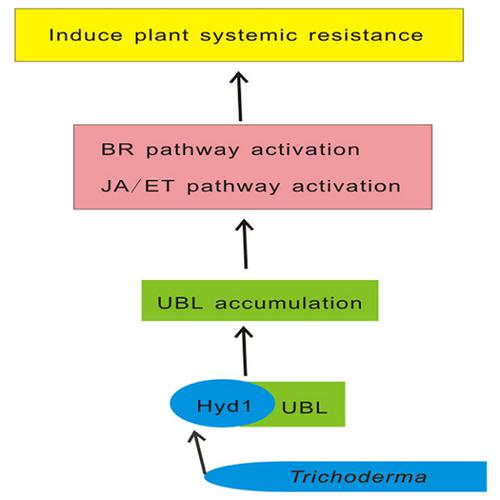当前位置:
X-MOL 学术
›
J. Integr. Plant Biol.
›
论文详情
Our official English website, www.x-mol.net, welcomes your feedback! (Note: you will need to create a separate account there.)
Elicitor hydrophobin Hyd1 interacts with Ubiquilin1‐like to induce maize systemic resistance
Journal of Integrative Plant Biology ( IF 11.4 ) Pub Date : 2019-05-17 , DOI: 10.1111/jipb.12796 Chuanjin Yu 1, 2 , Kai Dou 1, 2 , Shaoqing Wang 1, 2 , Qiong Wu 1, 2 , Mi Ni 1, 2 , Tailong Zhang 1, 2 , Zhixiang Lu 1, 2 , Jun Tang 3 , Jie Chen 1, 2
Journal of Integrative Plant Biology ( IF 11.4 ) Pub Date : 2019-05-17 , DOI: 10.1111/jipb.12796 Chuanjin Yu 1, 2 , Kai Dou 1, 2 , Shaoqing Wang 1, 2 , Qiong Wu 1, 2 , Mi Ni 1, 2 , Tailong Zhang 1, 2 , Zhixiang Lu 1, 2 , Jun Tang 3 , Jie Chen 1, 2
Affiliation

|
Trichoderma harzianum is a plant‐beneficial fungus that secretes small cysteine‐rich proteins that induce plant defense responses; however, the molecular mechanism involved in this induction is largely unknown. Here, we report that the class II hydrophobin ThHyd1 acts as an elicitor of induced systemic resistance (ISR) in plants. Immunogold labeling and immunofluorescence revealed ThHyd1 localized on maize (Zea mays) root cell plasma membranes. To identify host plant protein interactors of Hyd1, we screened a maize B73 root cDNA library. ThHyd1 interacted directly with ubiquilin 1‐like (UBL). Furthermore, the N‐terminal fragment of UBL was primarily responsible for binding with Hyd1 and the eight‐cysteine amino acid of Hyd1 participated in the protein‐protein interactions. Hyd1 from T. harzianum (Thhyd1) and ubl from maize were co‐expressed in Arabidopsis thaliana, they synergistically promoted plant resistance against Botrytis cinerea. RNA‐sequencing analysis of global gene expression in maize leaves 24 h after spraying with Curvularia lunata spore suspension showed that Thhyd1‐induced systemic resistance was primarily associated with brassinosteroid signaling, likely mediated through BAK1. Jasmonate/ethylene (JA/ET) signaling was also involved to some extent in this response. Our results suggest that the Hyd1‐UBL axis might play a key role in inducing systemic resistance as a result of Trichoderma‐plant interactions.
更新日期:2019-05-17



























 京公网安备 11010802027423号
京公网安备 11010802027423号